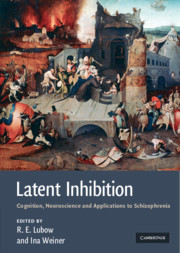Book contents
- Frontmatter
- Contents
- List of contributors
- Preface
- 1 A short history of latent inhibition research
- Current topics in latent inhibition research
- 2 Latent inhibition and extinction: their signature phenomena and the role of prediction error
- 3 Inter-stage context and time as determinants of latent inhibition
- 4 Latent inhibition: acquisition or performance deficit?
- 5 Latent inhibition and learned irrelevance in human contingency learning
- 6 Associative and nonassociative processes in latent inhibition: an elaboration of the Pearce–Hall model
- 7 From latent inhibition to retrospective revaluation: an attentional-associative model
- 8 Latent inhibition and habituation: evaluation of an associative analysis
- 9 Latent inhibition and creativity
- 10 The phylogenetic distribution of latent inhibition
- 11 The genetics of latent inhibition: studies of inbred and mutant mice
- 12 A comparison of mechanisms underlying the CS–US association and the CS–nothing association
- 13 The pharmacology of latent inhibition and its relevance to schizophrenia
- 14 Parahippocampal region–dopaminergic neuron relationships in latent inhibition
- 15 Latent inhibition and other salience modulation effects: same neural substrates?
- 16 What the brain teaches us about latent inhibition (LI): the neural substrates of the expression and prevention of LI
- 17 Latent inhibition in schizophrenia and schizotypy: a review of the empirical literature
- 18 A cautionary note about latent inhibition in schizophrenia: are we ignoring relevant information?
- 19 Latent inhibition as a function of anxiety and stress: implications for schizophrenia
- 20 Nicotinic modulation of attentional deficits in schizophrenia
- 21 Latent inhibition and schizophrenia: the ins and outs of context
- Summary and conclusions
- Index
- References
5 - Latent inhibition and learned irrelevance in human contingency learning
from Current topics in latent inhibition research
Published online by Cambridge University Press: 04 August 2010
- Frontmatter
- Contents
- List of contributors
- Preface
- 1 A short history of latent inhibition research
- Current topics in latent inhibition research
- 2 Latent inhibition and extinction: their signature phenomena and the role of prediction error
- 3 Inter-stage context and time as determinants of latent inhibition
- 4 Latent inhibition: acquisition or performance deficit?
- 5 Latent inhibition and learned irrelevance in human contingency learning
- 6 Associative and nonassociative processes in latent inhibition: an elaboration of the Pearce–Hall model
- 7 From latent inhibition to retrospective revaluation: an attentional-associative model
- 8 Latent inhibition and habituation: evaluation of an associative analysis
- 9 Latent inhibition and creativity
- 10 The phylogenetic distribution of latent inhibition
- 11 The genetics of latent inhibition: studies of inbred and mutant mice
- 12 A comparison of mechanisms underlying the CS–US association and the CS–nothing association
- 13 The pharmacology of latent inhibition and its relevance to schizophrenia
- 14 Parahippocampal region–dopaminergic neuron relationships in latent inhibition
- 15 Latent inhibition and other salience modulation effects: same neural substrates?
- 16 What the brain teaches us about latent inhibition (LI): the neural substrates of the expression and prevention of LI
- 17 Latent inhibition in schizophrenia and schizotypy: a review of the empirical literature
- 18 A cautionary note about latent inhibition in schizophrenia: are we ignoring relevant information?
- 19 Latent inhibition as a function of anxiety and stress: implications for schizophrenia
- 20 Nicotinic modulation of attentional deficits in schizophrenia
- 21 Latent inhibition and schizophrenia: the ins and outs of context
- Summary and conclusions
- Index
- References
Summary
Introduction
To say that latent inhibition (LI) is a well-established phenomenon of animal conditioning is a serious understatement. Since its first demonstration 50 years ago, the finding of a retardation in conditioning following nonreinforced preexposure to a stimulus has been reported countless times across species from sheep to snails, and from goats to goldfish.
Given the ubiquity of LI in animal conditioning, and the suggestion that, under some circumstances at least, a common associative mechanism might also underlie human contingency learning (the acquisition of knowledge about the predictive relationship between a cue and an outcome; Dickinson, Shanks, & Evenden,1984), we might expect a search of the contingency learning literature to reveal many demonstrations of LI in humans. The conclusions to be drawn from such a search depend largely on whether an empirical or theoretical approach to LI is taken.
An empirical approach to LI
If we define LI empirically, as the experimental observation of a retardation in the development of conditioned responding to a stimulus resulting from nonreinforced preexposure to that stimulus, then we must conclude that LI has been demonstrated many times in human contingency learning (e.g. De la Casa, Ruiz, & Lubow, 1993b; Ginton, Urca, & Lubow, 1975; Gray, N.S., et al., 2001; Lubow, Ingberg-Sachs, Zalstein-Orda, & Gewirtz, 1992). For example, during Ginton et al.'s preexposure phase, participants were required to report the number of repetitions of a list of nonsense-syllables (a masking task; see below). The to-be-conditioned stimulus (CS), a burst of noise, was interspersed throughout presentation of this list.
- Type
- Chapter
- Information
- Latent InhibitionCognition, Neuroscience and Applications to Schizophrenia, pp. 94 - 113Publisher: Cambridge University PressPrint publication year: 2010
References
- 6
- Cited by

